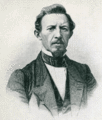Template:Selected anniversaries/June 24: Difference between revisions
No edit summary |
No edit summary |
||
| Line 36: | Line 36: | ||
||1880: Jules Antoine Lissajous dies ... mathematician and academic ... after whom Lissajous figures are named. Among other innovations, Lissajous invented the Lissajous apparatus, a device that creates the figures that bear his name. In it, a beam of light is bounced off a mirror attached to a vibrating tuning fork, and then reflected off a second mirror attached to a perpendicularly oriented vibrating tuning fork (usually of a different pitch, creating a specific harmonic interval), onto a wall, resulting in a Lissajous figure. Pic. | ||1880: Jules Antoine Lissajous dies ... mathematician and academic ... after whom Lissajous figures are named. Among other innovations, Lissajous invented the Lissajous apparatus, a device that creates the figures that bear his name. In it, a beam of light is bounced off a mirror attached to a vibrating tuning fork, and then reflected off a second mirror attached to a perpendicularly oriented vibrating tuning fork (usually of a different pitch, creating a specific harmonic interval), onto a wall, resulting in a Lissajous figure. Pic. | ||
File:Oswald Veblen 1915.jpg|link=Oswald Veblen (nonfiction)|1880: Mathematician and academic [[Oswald Veblen (nonfiction)|Oswald Veblen]] born. His work will find application in atomic physics and the theory of relativity. | File:Oswald Veblen 1915.jpg|link=Oswald Veblen (nonfiction)|1880: Mathematician and academic [[Oswald Veblen (nonfiction)|Oswald Veblen]] born. His work will find application in atomic physics and the theory of relativity. Veblen will publish a paper (1912) on the [[Four color theorem (nonfiction)|Four color conjecture]]. | ||
||1883: Victor Francis Hess born ... physicist and academic, Nobel Prize laureate. | ||1883: Victor Francis Hess born ... physicist and academic, Nobel Prize laureate. | ||
Revision as of 06:24, 25 June 2019
1660: Priest, astromomer, and crime-fighter Giovanni Battista Riccioli publishes new scheme of lunar nomenclature which anticipates future developments in the detection and prevention of crimes against astronomical constants.
1709: The public test of the "Passarola", a primitive airship devised by priest and inventor Bartolomeu de Gusmão, fails to take place.
1860: Inventor and engineer Wilhelm Bauer publishes complete working plans for a submarine which is undetectable by alleged supervillain Neptune Slaughter.
1880: Mathematician and academic Oswald Veblen born. His work will find application in atomic physics and the theory of relativity. Veblen will publish a paper (1912) on the Four color conjecture.
1886: Alice Beta and Niles Cartouchian Play Chess wins Pulitzer prize, hailed as the "most entertaining illustration of our time."
2008: Mathematician and academic Gerhard Ringel dies. Ringel was a pioneer of graph theory and contributed significantly to the proof of the Heawood conjecture (now the Ringel-Youngs theorem), a mathematical problem closely linked with the Four color theorem.
2016: Steganographic analysis of Boxes unexpectedly reveals previously unknown type of cryptographic numen. APTO engineers call it "a remarkable breakthrough."






